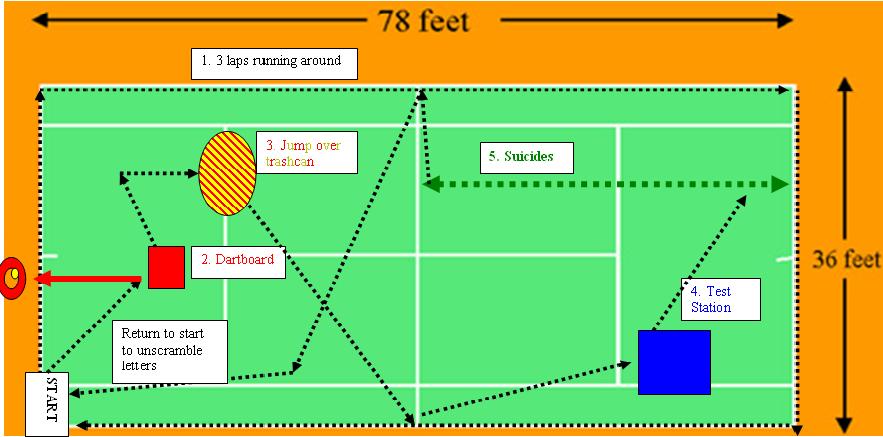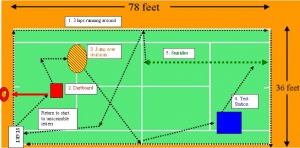Obstacle Course
From ThePlaz.com
For IPS (Science) - ThePlaz and Jeff, Beau, Tom had to create an Obstacle Course on a tennis court demonstrating the physics principles we had learned in Unit 1 - Motion. This project was completed around November 2005. We chose to do a obstacle course that not only used physics but tested the participants knowledge of the physics principles we had learned. We did this mostly through a quiz at the end that participants needed to solve correctly to unscramble a secret code word. This meant that a runner needed not just athletic skill, but physics knowledge to complete the course. This made our course not too popular with the students, but very popular with the teacher. Unfortunately the students were the ones picking the winning courses, so we lost. The winning course was suppose to be built and we would actually run it, but this plan fell through and we never built any of the courses.
Contents |
Teacher Directions
A Microsoft Word version of this work is available here: Image:IPSAssessmentObstacleCourse.doc
===Scenario=== Remember when you were a young small laddie/lassie in elementary school and you competed in Field Day. You may have enjoyed the events, you may have thought you could design a much better course with better events. Well, here is your chance.
===Challenge=== Create a fun and challenging obstacle course in which the physics principles that we have learned can be measured or demonstrated.
Details/ Course Specifications:
- The course dimensions will have to be within the limits of a tennis court (Haverford High School).
- Minimum of four skill events that measure or demonstrate the following physics principles:
- Average Speed
- Instantaneous Speed
- Acceleration
- Projectile Motion
- The full course will be run a total of 4 times by either 3 or 4 people on the team in a relay method, i.e., one person runs through the course comes back and tags the next person.
- Due to the relay nature of the obstacle course, the course must be exactly the same after each student runs through it, as it was before the student ran through it.
- You obstacle course must be safe for all students to go through.
Here’s the great part
Once you have come up with a successful and fun design that meets the criteria, your class will vote on the best course design. The best design from our class will go head to head against the best from other IPS classes’ designs during the same block. All of the students that have IPS during that block will have the opportunity to vote on the design that they feel is the best. That obstacle course will be the one that you- the IPS students- run and compete on. Two identical obstacle courses will be made side by side. Students from all of the classes during that block will be challenged to complete that obstacle course in the shortest amount of time possible. The two fastest teams will go head to head against each other in the championship round.
Grade
You will be graded on your presentation to the class based on a rubric that we make up together. Your presentation to the class will include a model/ visual representation of your obstacle course. You must demonstrate (on the visual representation) how the above physics principles are incorporated into the events. When applicable you should include numbers and sample calculations.
Course Explanation
A Microsoft Word version of this work is available here: Image:Obstacle Course Explanation.doc
We recently had the opportunity to design an obstacle course based on physics principles. The course had to be easily created using basic materials already available to us. The course would have to be built twice, side by side on two tennis courts of standard proportions. Also, the course had to measure people’s knowledge of physics principles. In the end, we decided on a simple course with a mix of fun activities, and those more challenging to the brain. We designed a course that can be easily and quickly built using standard materials already found in the classroom. The course covers and goes well beyond the required physics properties stated in the directions, challenging and evaluating the knowledge gathered during the last quarter of IPS 9H.
The course begins with everyone standing on a starting mat. When an official says go, one person will begin running around the perimeter of the tennis court. Another student will have a stopwatch and begin timing when the person starts running. The runner will have to run around the tennis court three times. They are not allowed to cut corners. If an official finds that a runner has cut corners, they will have to return to the start and the runner and the timers will have to start over. Once the runner has circled around the court three times (to the amount of 684 ft or 208 meters) they may move onto the next station. The timer then stops timing and moves to the testing station, (#4) there they must figure the average speed of the runner and their average velocity. They must use the figure 208 meters to calculate average speed and average velocity. They will then write the average speed and average velocity on the provided index card and hand it to a race official. The average speed will vary, but should be between 3 to 7 m/sec. The average velocity must be figured at zero. The timer then goes back to the start mat. The timer can time again for another runner, though must be a runner once himself as someone else times. This step of our obstacle course makes a participant figure out average speed and how that differs from average velocity. Average speed is defined as distance traveled divided by the time it takes to travel that distance. In this example, the runner runs 208 meters in a certain amount of time that the timer determines. The timer then figures the average speed using distance/time formula. The average velocity concept is the same as average speed, except it is a vector, not a scale quantity. Because the runner returns back where he started, his average velocity is 0.
In step 2, the runner will encounter the physics property of projectile motion. The runner must throw a magnetic dart at a magnetic dart board. The runner must throw the dart into the specified inner circle from the specified throwing mat. If the runner misses the inner circle, they must try again till they are able to make it into the inner circle with a dart. If they run out of darts, they must go and collect all darts thrown by them and the runner(s) before them, and keep trying. Once a runner throws a dart into the inner circle they can move on to the next step. The dart is a projectile because, once released, it is affected only by gravity and air resistance. The dart follows the rules of projectile motion once thrown. The runner must be able to figure out the rules of projectile motion to throw the dart with a certain speed and direction to be able to hit the center ring of the targets.
In step 3, the runner has the opportunity to become a projectile themselves. They must apply enough force to overcome gravity and jump over a trashcan lying on its side. If the runner does not apply enough force, they are not able to clear the trashcan either vertically or horizontally. Once the runner has successfully completed the jump, they may move over to the testing station, #4.
Step 4 tests the runner on a variety of physics topics we covered in class, including instantaneous speed. Instantaneous speed is just average speed using a small amount of time. It is figured distance/small amount of time it took to travel that distance. Once the runner has arrived at the testing station, the runner will select one of four different tests. Each test differs in length and difficulty. They must choose a test different then the runners before them. Once they have chosen a test, they may not switch to a different test. The runner then follows the directions printed on the top of the test. The instruction instruct the runner to answer each multiple choice test question and place the answer they think is correct on an index card. It is easier to put each letter on a different index card. No one is able to help the tester take his test or determine if the answers are correct. Once the runner believes all his answers are correct, he or she may move on to the next station, taking with them their index cards. Remember, no one, not even a teacher or official may tell a runner if the questions are correct or provide help with the questions. A calculator will be available at each test station for the runner’s use.
At the next station, the runner will take the provided accelerometer and hold it on their hip. It is easier to hold the accelerometer with the paperclip not touching the paper, in order to get a better reading. The runner will now have to participate in a running drill called “suicides.” The runner will have to start at the back of the court and run halfway to the net. A line should be on the court indicating the halfway line. At the line, The runner must then decelerate and change direction and velocity to head back to the outside perimeter of the tennis court. Once back to where he or she put on the accelerometer, the runner must decelerate and change direction and velocity again to head back toward the center net of the tennis court. Once there, they turn around and head back to the outside perimeter of the tennis court where they can take off their accelerometers. Then they must maneuver around the net back to the starting mat. This step shows the physics property of acceleration. The runner must constantly change speed and direction in order to complete this step. First they speed up from stating still after they put on their accelerometers. Then they must slow down to change direction and velocity. Once they arrive again at the point where they put on their accelerometers, the runner must change directions again. It is hard to change direction without changing your speed.
Once they arrive again at the starting mat, they may select another runner and timer to run on the course. Then they must unscramble the letters they figured out at the testing station. Other team members may help with this step. Each runner will make up a separate word with their letters. If a team member believes they don’t have the correct letters because they answered a question incorrectly, they may themselves go, one at a time, directly back to the testing station to take another look at their test only. The first team to unscramble all of thin letters into words and then arrange their words into a sentence, and shout out that secrete sentence correctly, wins!
Diagram
A Microsoft Word version of this work is available here: Image:Obstacle Course Diagram.doc

Quizzes
A Microsoft Word version of this work is available here: Image:Obstacle Course Quiz 1.doc
A Microsoft Word version of this work is available here: Image:Obstacle Course Quiz 2.doc
A Microsoft Word version of this work is available here: Image:Obstacle Course Quiz 3.doc
A Microsoft Word version of this work is available here: Image:Obstacle Course Quiz 4.doc



